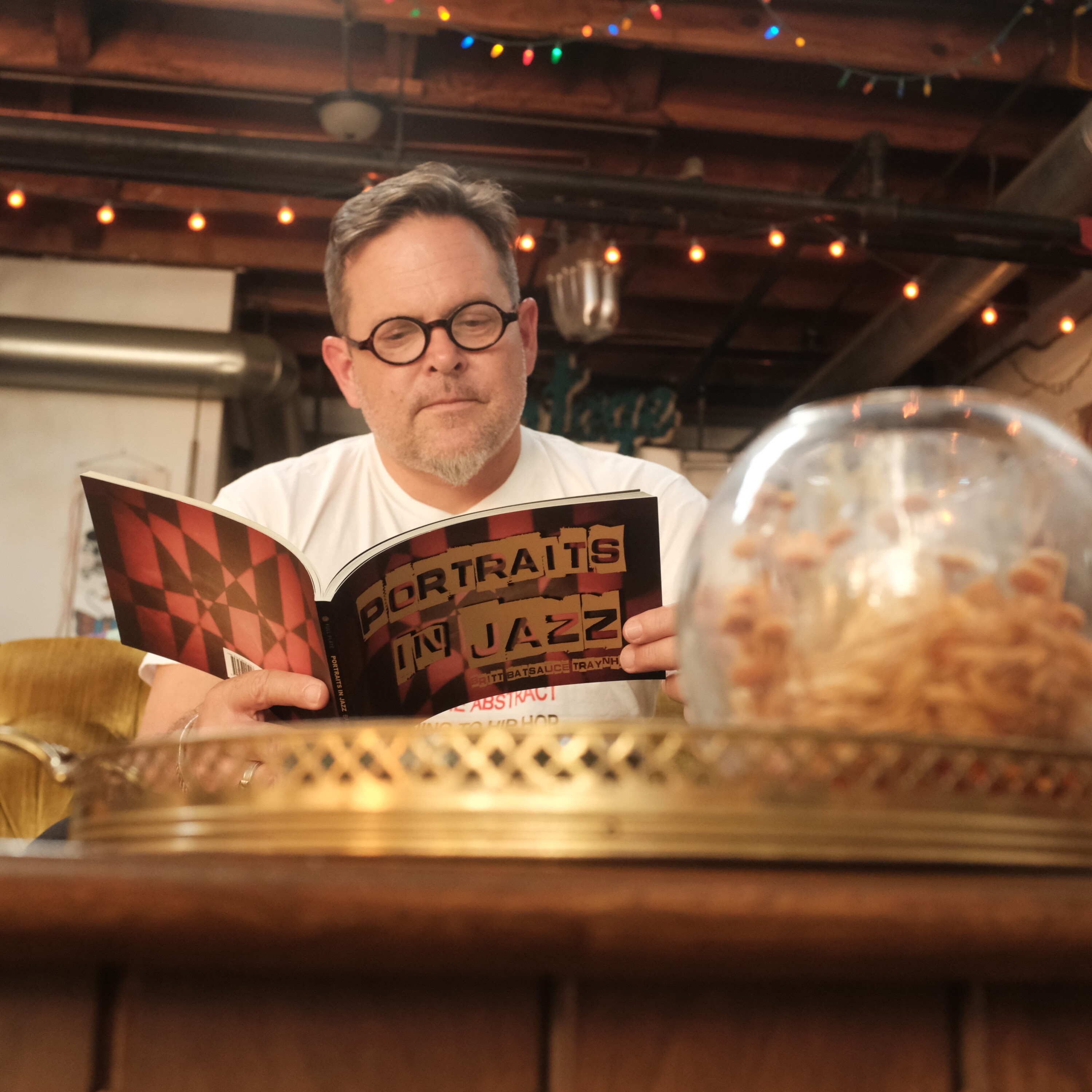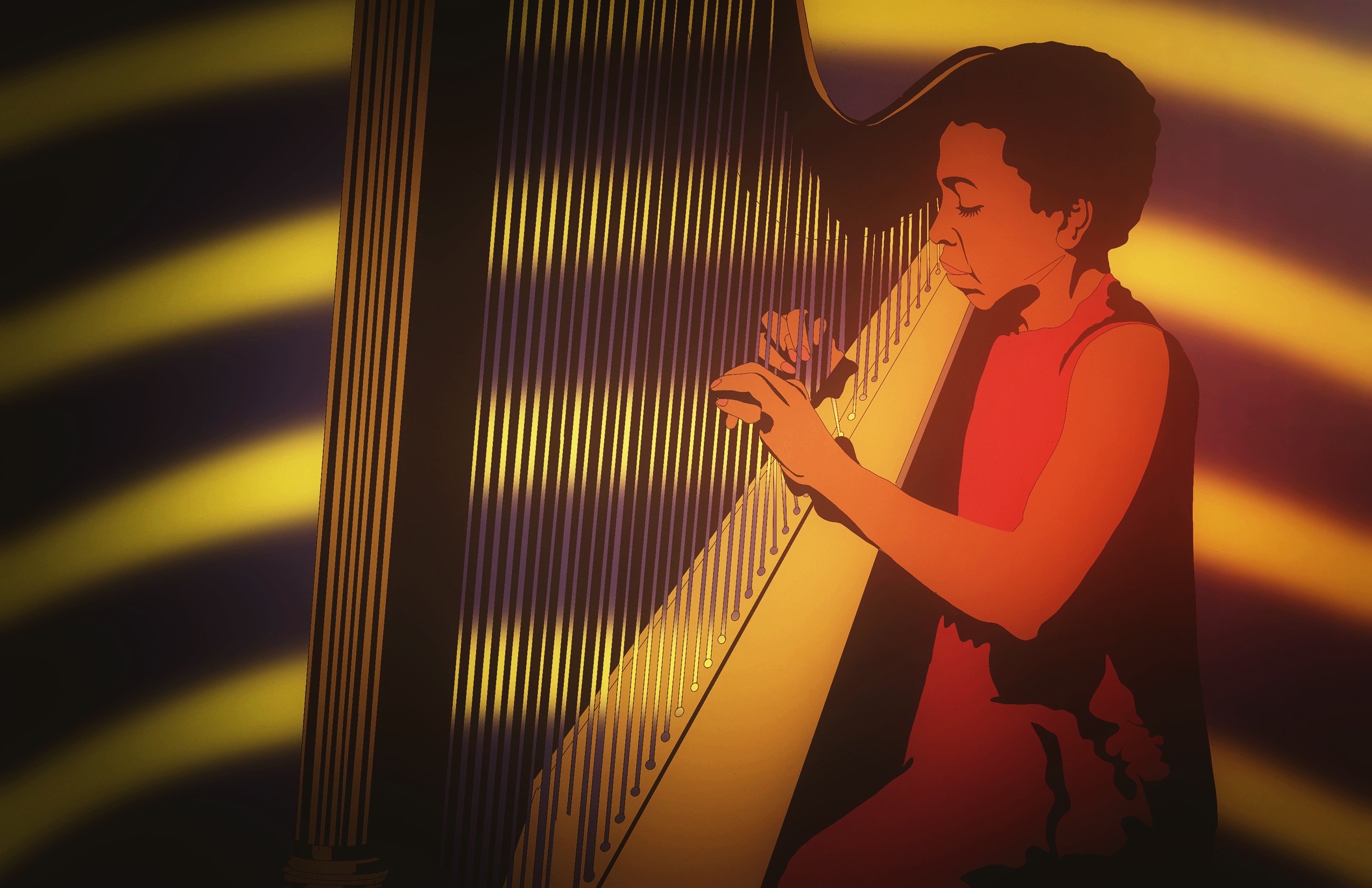
Over the course of a career that’s now well into its fourth decade, the work of Britt Traynham has always been defined by a dogged diversity, and a relentless work ethic that has now taken him around the world, several times over. He currently lives in Hawaii with his wife and longtime collaborator, Lady Daisey, a veteran singer-songwriter and graphic designer in her own right. They have worked together for years as Heavenly Noise, in addition to their legendary trio project with the late great Paten Locke, The Smile Rays. As Batsauce, Traynham has figured prominently in a variety of albums seminal to the local scene, including collabs with Big Band Theory, Dillion Maurer and Patrick Evan.
The book, Portraits In Jazz (Full Plate), is a whole new venture for Traynham, but one he’s pursued with typical vigor. For the project, Traynham prepared 50 short essays about various jazz artists, each of which is paired with his illustration of that artist. “I used to be an elementary art school teacher,” he says, “so I’m returning to my love of the visuals — and combining that with my love of music, specifically jazz.” The latter aspect is intriguing for longtime fans of his who, like me, have only a passing familiarity with his visual art, though Traynham has worked in everything from spray-paint to computer animation.

As anyone who’s ever tried to keep up with him at the airport would attest, Traynham moves fast, and this is no exception. “It took me 6 weeks to draw the 50 artists, he says, “and another month or so to do the research and the writing.”
As a DJ and producer, he’s been long familiar with the material being discussed. “As far as who I’ve sampled the most, that’s a good question,” he says. “My favorite artist of all time is Coltrane, but I haven’t sampled him much. I have sampled a fair amount of Bobby Hutcherson, Nina Simone, and Bobbi Humphrey.” Fans can recognize some of the samples in his work and that of others, but the text functions as one fan’s personal devotional to an era of unprecedented creativity that many of us still study like Scripture.
The project is dedicated to Jacksonville producer and hip-hop artist Paten Locke, one of the most prolific crate-diggers who ever lived, a man with whom Traynham spent hours at home, in studio and on the road discussing some of these very same people. “Paten had such an encyclopedic memory of musicians that I doubt there would be many in the book that he wouldn’t be aware of,” says Traynham. “I’d say there are a few artists I got hip to while hanging out with Paten, like Dorothy Ashby and Bobbi Humphrey. Most of these artists, though, I’ve been listening to since my college days at UNF.”
What really makes the book a breeze is its brevity. Traynham eschews the kind of intense scholarly analysis that he’s fully capable of (especially in discussion) in favor of emphasizing the visceral impact of the music. His impressions are drawn from a lifetime of listening, but he writes like he’s chronicling his first impressions. We all know how quickly it can click, to hear certain tracks for the first time. The beginning of “So What”, “Take Five” or even “Sing Sing Sing” are so ingrained in the public consciousness, and I’m sure the reader can immediately recall their own early experiences with that material.




The text flows is roughly chronological order, starting with Ferdinand “Jelly Roll” Morton, the pianist who helped codify the mythos of Storyville. The meat of the material is concerned with bebop, rebop, hard bop and post-bop, with several pages devoted to the experimental and avant-garde jazz that began to flourish in the late 1960s (Traynham also includes a profile of pianist Bill Evans, whose 1960 trio album Portrait In Jazz inspired the title of his book, as well as a final, 51st profile of himself.) With so many legends of the business, such a project could go on forever, with infinite room to subdivide the subject based on geography, chronology, race, gender and especially instrumentation. So he had to pick wisely, and he did.
When reading the book, I was struck that the content would work really well with a playlist of some kind to accompany the text, and I started thinking of selections in my mind. When I made the suggestion to Traynham later, he duly pointed out the bookmark that came with the book. On one side is an image and quote from multi-instrumentalist Rahsaan Roland Kirk (1935-1977): “Keep searchin’ for your mystery note on the universal piano of life.” On the other side of the bookmark is a QR code that does lead to a custom mix of music by these artists. As one might expect from a veteran selector of such high standing, his selections are quirky, but spot-on. In some cases, I’d have picked the same tracks; in most other cases, he picked even better.
Portraits In Jazz sold out its entire first edition in a matter of days, and eager fans have bitten out a sizable chunk of the second printing, as well. Traynham plans to expand the franchise into other genres in 2023 and beyond, and it will be interesting to see what he does next, on and off the page.

Mr. Al Pete and Notsucal Release Their Latest Collab, ‘G4.5’

Dinner Party, Tom Misch and More from the Neighborhood with Mr. Al Pete

An Ultra-Chill Playlist from the Latest Episode of Electro Lounge

Sing Out Loud Festival Returns With Hozier, Beabadoobee, Father John Misty, Vance Joy and More

Chicago Alt-Country Faves Wilco Return to St. Augustine with Indie-Folk Great Waxahatchee

Looking for an Alternative to Spotify? Consider Hopping on the band(camp) Wagon

Khruangbin to Bring ‘A LA SALA’ Tour to St. Augustine in April

Perfume Genius, Flipturn, Tamino + Mitski and 6 New Songs to Stream

Song of the Day | “all tied up” by Glixen




